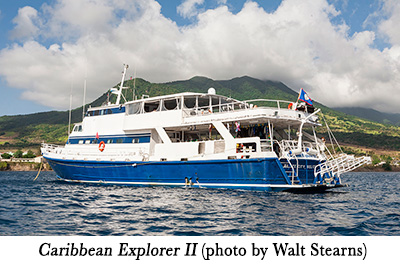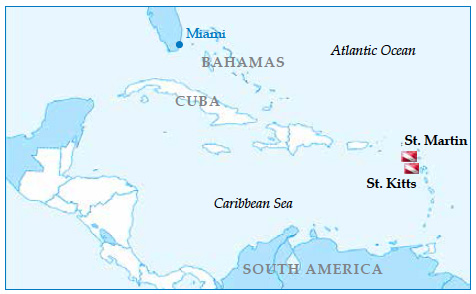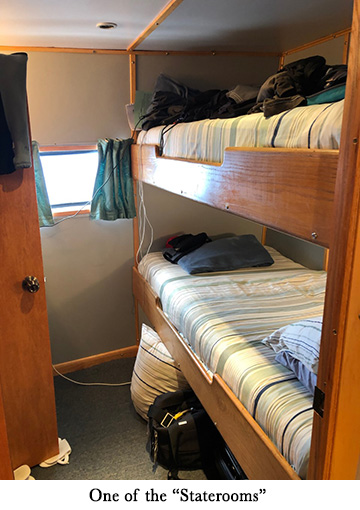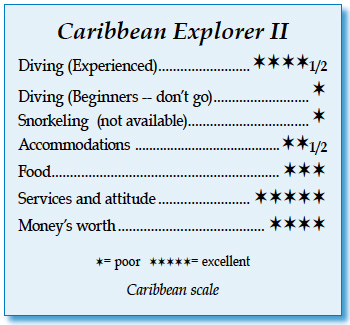Caribbean Explorer II, Saba, St. Kitts, St. MartinContents of this Issue: Caribbean Explorer II, Saba, St. Kitts, St. Martin Why Does Explorer Ventures Still Have a Fuel Surcharge? Are We Americans Good Tippers or Just Total Suckers? El Galleon Resort & Asia Divers, Philippines Apple’s iPhone Plans to Lure Underwater Photographers What’s Your Real Risk of a Diving Death? More Global Shipping Means More Invasive Marine Species on Coral Reefs He Was 330 Feet Deep Without Anything to Breathe -- and Survived How You Can Get Great Underwater Pictures Top Tips from Other Dive Photo Pros The Mission to Save Our Oceans By Next Year Editorial Office: Ben Davison Publisher and Editor Undercurrent 3020 Bridgeway, Suite 102 Sausalito, CA 94965 reefs survived the hurricanes, but the boat is showing its age from the June, 2019 issue of Undercurrent
Dear Fellow Diver: The last time I had traveled aboard the Caribbean Explorer II (CExII) was before Hurricane Irma roared through the Caribbean in September 2017. When I got the chance to go again in April, I was eager to see how the reefs had fared, yet scared, too -- was it too soon, and was I expecting too much? Well, I've got good and bad news. The island of Sint Maarten/Saint Martin remains a mess, its airport still marked by exposed ceilings, no Wi-Fi and few facilities. But astonishingly, the diving off Saint Kitts and Saba seems virtually untouched by hurricane damage -- the reefs looked great.
I wish I could say the CExII is doing great, too, but this grande dame is one of the older liveaboards around (it began its liveaboard life in 1986 as the Sea Dancer out of Providenciales) and is showing its age. Though it sleeps 18 guests and six crew, quarters are super-tight. Cabins (I can't call them staterooms, as they are neither stately nor roomy) are small by today's standards. My cabin, number 4, was so tiny there was no place at all to sit down. I was lucky not to have a roommate, because there were no shelves or drawers; at least I could use the top bunk for storage. Other cabins have a tad more room and some storage. My fellow divers noted how cold the AC was; indeed, the only way I could keep mine tolerable was by packing pillows in front of the bellowing vent. Engineer Brett told me the boat may be getting individual cabin thermostats, but "may" is the operative word. Explorer Ventures knows it's an older boat, so the trip cost is proportionate. Because there was no place to sit in my cabin, I wrote my log in the salon and socialized with fellow passengers -- a dive club from New York, a couple from Italy, another from Tennessee, and three single travelers, including me. It's polarizing times even on a Caribbean dive trip. When the topic of politics came up, flashpoints ignited between those who support our current President and those appalled by him. I never talk politics in a group setting, but boy, I overheard some real wrangling during afterdinner conversations in the salon. Longtime Captain Ian, British by birth, gave sardonic briefings laden with underthe- radar humor. A member of the dive staff was on every dive, sometimes Tay or Kirsten from South Africa, Sarah from Massachusetts, or Demian from Holland. The most important person on the boat, Chef Julian from Scotland, kept us fed five times a day, though his food was workmanlike. (I missed Chef Cathy, who had spoiled me on my previous trip with her highly trained, creative and gourmet hands in the galley.) It was a five-foot drop into the water from the port side. This was no problem for most of us, but for two inexperienced divers (only two saltwater dives, and maybe 17 dives total), that drop into often-choppy seas freaked them out. They told me they had been assured that the diving was suitable for very new divers, but I say B.S. to that. Rough seas, some current and low visibility (30 feet or less was not uncommon) and rough re-entry on a tossing stern deck, require real comfort in the water. I had to doff my fins while hanging onto the dinghy line, hand them up to staff, then climb the ladder. One of my buddies, a very experienced tech diver, hated doffing his fins. I understand why this was the practice, but it was sometimes hard to grab the ladder while finless in the rough seas. So I would call this moderately advanced Caribbean diving.
Because my trip began in Saint Kitts and ended in Sint Maarten, the diving started with the more tame, less deep sites off Saint Kitts. Visibility wasn't great (it never is) on the M/V River Taw, a wreck scattered across the bottom of Basseterre Bay. Thanks to a mucky bottom, I never saw farther than 30 feet but there was lots to see up close. Yellow-headed jawfish popped up and down in the seagrass, while a large female green turtle quietly nosed around nearby for a snack. A stingray cruised the flats, and at one point, a lovely eagle ray joined it. I took a short swim away from the stern section of the wreck to see the remains of a bulldozer and the chassis of a van, mostly interesting for the lobsters and eels tucked in their structures. After the first dive, Julian offered sweet snacks, like a moist lemon cake, brownies and oatmeal cookies. The 11 a.m. snack was followed by lunch -- meatballs, pasta, salad, pizza, soup, hamburgers and veggie burgers -- and because several crew members are vegan, Julian offered plenty of vegetarian and vegan options for everyone. Afternoon snacks, offered in between the 2 p.m. and 4:45 p.m. dives, tended to the savory, such as chicken wings, quesadillas, and cheese and veggie dip. Dinner, served before the night dive, ranged from grilled mahi-mahi and fresh wahoo to pork loin wrapped in bacon (pork with more pork!) and filet mignon, served with sides like roasted potatoes, rice, and mac and cheese. There were always cooked veggies, like gingered carrots and savory green beans, and a salad. While all the meals were filling, they weren't refined. Julian's masterpiece was his home-baked breads. I sometimes spied one rising under a dish towel at breakfast, and that made me look forward a bit more to lunch or dinner.
I always saved my desserts -- key lime pie, chocolate cheesecake, tiramisu, and apple crisp with homemade ice cream -- for after the night dive and a warm shower, pairing them with a hot toddy. Wine, beer and spirits were included in the trip price, though, of course, the first one of those signaled the end of your dive day. One day, the boat steered over to the nearby island of Nevis (the birthplace of Alexander Hamilton) for a couple of dives on Monkey Shoals. My two buddies and I gladly followed the dive staff here through the series of hard-to-navigate coral heads, but the payoff was spotting nurse sharks, a robust green moray and fine batwing crabs. Water temperatures were lower than you'd expect for April in the Caribbean -- most dives came in at 77 or 78 degrees, with a few at 75, and even one at 73 degrees. I'm a wimp and typically wear a 7mm as my default, but it was definitely needed on this trip, and I still added a 3.5mm hooded vest. Still, one magical aspect of diving this area in springtime is hearing the sounds of transiting whales, particularly at night. Sarah excelled at imitating whale calls, and from her I learned that the "bing-whimper" I kept hearing were likely orcas. We also heard the sliding wails of humpbacks. Perfectly enchanting. Sarah was a good spotter, too. At Anchors Aweigh, a Saint Kitts dive that got its name from enormous sponge- and coral-encrusted anchors dotting the coral heads and sand, she found several frogfish tucked into the coral heads. I saw two big yellow females, exactly the color of nearby sponges, and found myself inspecting every yellow sponge on the next dive. Saba dive sites are more dramatic than Saint Kitts', but also more exposed, with stronger currents and deeper dive sites -- another reason I'd not recommend new divers on this itinerary. I descended down Tedran Wall (named for local dive guides Ted and Randy), a deep series of pinnacles, with dark sand chutes between them, overhanging the wall descending into the abyss. Huge deepwater gorgonians grew out from the pinnacles, outlined black against deep azure in the morning light. A big green turtle swam majestically into the blue. Were it not for the depth (the top of the dive is about 65 feet), I could stay here all day.
My buddies and I chose not to do the two land tours on Saint Kitts (old sugar plantation and local monkey plantation) and Saba (dramatic topography above water, too) so we could dive instead. I'm glad we did, because conditions at Diamond Rock finally calmed down enough for Captain Ian to moor there. Diamond Rock's slanting sides, encrusted with sponges, caught the afternoon light as we slowly finned around it. I really got the sense of tectonic drama from its upthrust slabs, and it provided a magnet for some seriously big fish -- I saw a yellowfin grouper, rare these days in the Caribbean, over three feet long. Horse-eye and bar jacks schooled, a queen trigger cruised by, and I counted nine queen angelfish nosing among the sponges. But it was the scenery and privacy of a small group that made this the most gorgeous dive of the trip. Yes, the CExII is an older, cramped boat showing its age, but the trip price reflects this, and the diving is impressively varied. The turtle population is terrific, and some of the sites are beautiful -- the recent batch of brutal hurricanes didn't do them in. There's enough pelagic and megafauna to keep adrenaline junkies happy, and the macro life is excellent. Tiny room and so-so meals aside, the boat's dedicated and hard-working crew also made this trip worthwhile. I don't think this was my final trip on CExII -- but I'll cross my fingers that I luck out and don't get a roommate on the next one, either. -- A.E.L. Our Undercover Diver's Bio: "I'm something of a fuss-budget diver, but it's based on diving all over the Indonesia, the Pacific, the Caribbean, the Red Sea and the Indian Ocean. I live part of the year in Bonaire, a favorite dive spot; my last two trips prior to this one were last year, first to Lembeh and Siladen, then Grand Cayman."
|

I want to get all the stories! Tell me how I can become an Undercurrent Online Member and get online access to all the articles of Undercurrent as well as thousands of first hand reports on dive operations world-wide
| Home | Online Members Area | My Account |
Login
|
Join
|
| Travel Index |
Dive Resort & Liveaboard Reviews
|
Featured Reports
|
Recent
Issues
|
Back Issues
|
|
Dive Gear
Index
|
Health/Safety Index
|
Environment & Misc.
Index
|
Seasonal Planner
|
Blogs
|
Free Articles
|
Book Picks
|
News
|
|
Special Offers
|
RSS
|
FAQ
|
About Us
|
Contact Us
|
Links
|
3020 Bridgeway, Ste 102, Sausalito, Ca 94965
All rights reserved.

 At Paradise Reef off Saint Kitts, I reveled in the dramatic
spur-and-groove topography at 60 feet and cruised over
the steep wall, enjoying the deep blue studded with craggy
coral heads. That's where I saw the biggest Southern stingray
I'd ever seen, sulkily lurking in the sand and easily
eight feet across. Big barracuda floated above the reef,
while rainbow runners streaked by. The topography's beauty
came with a price -- it was a tad confusing to navigate --
so I suggested to my buddies near the end of the dive that
we surface after a safety stop and get our bearings (hey, I don't mind
asking for
directions).
Next dive on
this site, I
navigated it
perfectly.
At Paradise Reef off Saint Kitts, I reveled in the dramatic
spur-and-groove topography at 60 feet and cruised over
the steep wall, enjoying the deep blue studded with craggy
coral heads. That's where I saw the biggest Southern stingray
I'd ever seen, sulkily lurking in the sand and easily
eight feet across. Big barracuda floated above the reef,
while rainbow runners streaked by. The topography's beauty
came with a price -- it was a tad confusing to navigate --
so I suggested to my buddies near the end of the dive that
we surface after a safety stop and get our bearings (hey, I don't mind
asking for
directions).
Next dive on
this site, I
navigated it
perfectly. The daily schedule called for four or five dives, but of my five dive days, three
were irregular because of land tours on Saint Kitts and Saba. I woke up for the 6:30
a.m. cold breakfast of breads, cereals, fruit and yogurt. More divers came out of their
cabins for the 7 a.m. hot breakfasts -- omelets, eggs with sausage or bacon, French
toast, pancakes, and egg sandwiches. Then we all suited up for the first dive, which
usually had us take that five-foot drop around 8:15 am.
The daily schedule called for four or five dives, but of my five dive days, three
were irregular because of land tours on Saint Kitts and Saba. I woke up for the 6:30
a.m. cold breakfast of breads, cereals, fruit and yogurt. More divers came out of their
cabins for the 7 a.m. hot breakfasts -- omelets, eggs with sausage or bacon, French
toast, pancakes, and egg sandwiches. Then we all suited up for the first dive, which
usually had us take that five-foot drop around 8:15 am. The first night dive of the trip was also on the River Taw, which I think should
have been called "Turtle River" instead. The wreck is home to lots of green turtles,
some feeding, so I tried to be kind and never aimed my light at them. But the gleaming
red eyes of shrimps and crabs picked up my dive light. Basket stars unfurled
and fed, and I watched one old male green turtle try unsuccessfully to shake off two big remoras from its carapace, but they were
determined hitchhikers. By the way, the boat
requires you to have a green or red light
attached to your tank on night dives (blue
is reserved for staff); if you don't bring
your own light, you must buy one from the
boat for $12.50.
The first night dive of the trip was also on the River Taw, which I think should
have been called "Turtle River" instead. The wreck is home to lots of green turtles,
some feeding, so I tried to be kind and never aimed my light at them. But the gleaming
red eyes of shrimps and crabs picked up my dive light. Basket stars unfurled
and fed, and I watched one old male green turtle try unsuccessfully to shake off two big remoras from its carapace, but they were
determined hitchhikers. By the way, the boat
requires you to have a green or red light
attached to your tank on night dives (blue
is reserved for staff); if you don't bring
your own light, you must buy one from the
boat for $12.50.  Some of our Saba dives were merely
nice, because current and rough seas sometimes
kept us away from the prettiest sites.
Customs House Reef, a fairly sheltered site,
was offered four times during the trip. Its
series of coral bommies boasted lots of fish
and turtles but lacked the drama of Saba's
deeper walls. We made a series of dives around
Tent Reef, encountering a powerful current on
one dive. I burned through a shameful amount
of gas getting from the entry to the mooring
line; my usual lackadaisical frog kick was
no match for the ripping current. Yet, other
dives there had little current. My favorite part of the Tent Reef complex was the boulevard of rocks on one side, and a miniwall
on the other at 40 feet. Dense with fish and turtles (including some of the only
hawksbills I saw), as well as lazy reef sharks, I could easily navigate it with little
current, and the plateau at 15 feet offered a great safety stop if one is comfortable
with its considerable surge.
Some of our Saba dives were merely
nice, because current and rough seas sometimes
kept us away from the prettiest sites.
Customs House Reef, a fairly sheltered site,
was offered four times during the trip. Its
series of coral bommies boasted lots of fish
and turtles but lacked the drama of Saba's
deeper walls. We made a series of dives around
Tent Reef, encountering a powerful current on
one dive. I burned through a shameful amount
of gas getting from the entry to the mooring
line; my usual lackadaisical frog kick was
no match for the ripping current. Yet, other
dives there had little current. My favorite part of the Tent Reef complex was the boulevard of rocks on one side, and a miniwall
on the other at 40 feet. Dense with fish and turtles (including some of the only
hawksbills I saw), as well as lazy reef sharks, I could easily navigate it with little
current, and the plateau at 15 feet offered a great safety stop if one is comfortable
with its considerable surge. Divers Compass: I booked directly with Explorer Ventures and my trip
cost $2,095, plus $115 for port fees, a $80 fuel surcharge, and $150
nitrox for the week . . . depending on the itinerary, you'll either fly
into Saint Kitts or Sint Maarten, and depart from the other . . . I took
American Airlines direct from JFK both ways; Delta and Jet Blue also fly
from the U.S., with Air Canada and British Airways coming from overseas
. . . Saint Kitts was not affected by Hurricane Irma, but Sint Maarten
is still hard-hit, especially the airport (no wi-fi there) . . . Website:
Divers Compass: I booked directly with Explorer Ventures and my trip
cost $2,095, plus $115 for port fees, a $80 fuel surcharge, and $150
nitrox for the week . . . depending on the itinerary, you'll either fly
into Saint Kitts or Sint Maarten, and depart from the other . . . I took
American Airlines direct from JFK both ways; Delta and Jet Blue also fly
from the U.S., with Air Canada and British Airways coming from overseas
. . . Saint Kitts was not affected by Hurricane Irma, but Sint Maarten
is still hard-hit, especially the airport (no wi-fi there) . . . Website: 